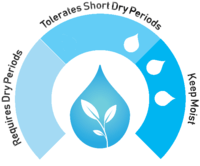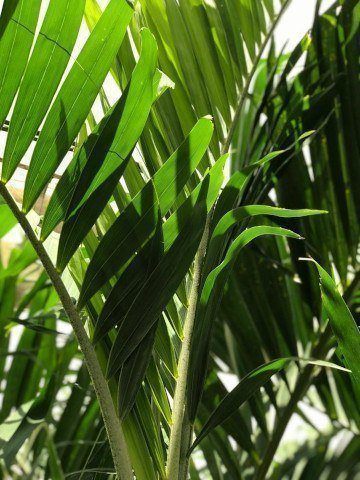
The Christmas palm is a solid interior plant for bright light areas. Our primary product is a field grown and shade acclimated triple stem palm finishing at 10 - 12 ft. Most of the Adonidias grown at Farm Life finish in a 21 inch pot, but some of the most outstanding specimens require a 24 inch container.
The meters below indicate a range of light and tolerance to drought. The ranges are indicated by the little light bulbs and the small water drops.
Light Instructions

Water Instructions


You should look for spider mites under the oldest leaves first on an Adonidia palm. Mites should be primarily controlled with predator mites. Neoseiulus californicus,(Spical, Spical Plus, Californiline) and Phytoseiulus persimilis,(Spidex, Bio Persimilis, Phytoline) are two excellent choices for spider mite control. If a mite infestation is exceptionally bad, prior to the release of predator mites, spray the plant with water or horticultural oil. Both will provide some knockdown control of spider mites and will not leave a toxic residue that may effect predator mites. If the population of spider mites is red in color, (as opposed to pale yellow with 2 dark black spots) then californicus mites are the only option. Even these predators do not feed heavily on the red spider mite. In this case spraying is the best option. Use a miticide that works well with californicus predator mites (Sultan, Floramite SC, Shuttle O).
Mealybugs can be removed with a systemic insecticide drench and hand cleaning. If pesticides are not an option, try horticultural oil directly sprayed onto the insects. A second and third treatment, if using oils, will be necessary. Space out the sprays at 3 week intervals to break up the mealybug life cycle.
Scale can be controlled the same way as mealybugs.
Palms will move potassium and magnesium from their oldest leaves up to the newest leaves. Spots on older leaves are usually a result of this process. If you use a fertilizer that is made for palms there should be an adequate supply of potassium. Magnesium should be supplied at half the rate of potassium. Check your fertilizer label for the relative rates of potassium and magnesium and supply additional magnesium if needed. It is best to keep large palms well fertilized for the duration of their life indoors. If the overall look of the palm is pale or yellow, increase the rate.
Adonidia palms should be kept moist without overwatering. Older foliage will droop when the palm is starving for water. A slight crease may develop right where the frond meets the stem before a noticeable droop occurs. Turgor pressure is needed to keep the heavy older foliage in the right orientation from the main stem. Large palms in difficult to check installations will benefit from a wetting agent added to the irrigation water or applied periodically. The wetting agent will help spread irrigation water to all parts of the soil which keeps all roots happy, and extends the time between waterings.
Other Links
Side Effects of Common Pesticides on Predator Mites
Designing a Fertilizer Program for Interior Tropical Foliage Plants
Zamioculcas zamifolia 'ZZ'
Adonidia merrillii
Aglaonema 'Aurora Siam'
